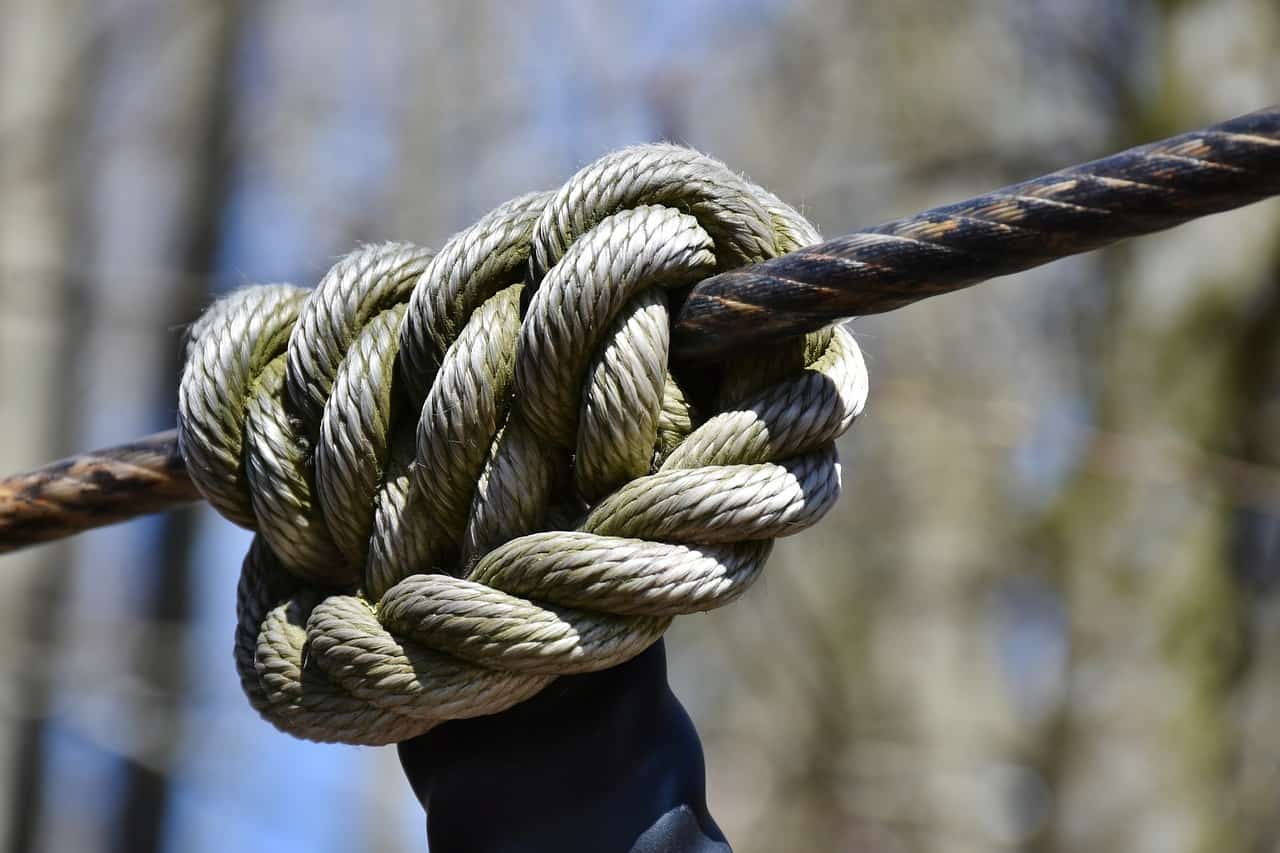People have been tying knots for thousands of years, yet they frequently take it for granted despite the fact that they use it on a daily basis. Knots have long been a crucial tool for anyone working on any project or activity, from practical applications to artistic techniques.
Paracord is an invaluable asset when you are camping, hiking, or in a survival situation. It also works great for boating, fishing, and some sports. Paracord is a lightweight rope or cord that is used to secure a parachute and rigging. As it turns out, paracord is useful for a whole lot of other things. Not only is it great for the outdoors, but you can also make bracelets, anklets, lanyards, and necklaces using paracord knots. In general, it’s an important tool to have especially for your preparedness activity.
Paracord is a rounded woven rope that comes in different sizes. The woven rope is round and tends to be stiff when you first purchase it. Because of its shape, paracord slides easily which is why paracord knots are so important. You can also do a variety of projects and crafts with paracord.
What Is a Paracord Knot?
Paracord knots are different knots to bind a paracord to either more cord/rope or bind it to an object. There are six types of recognized paracord-specific knots. These types are useful because of the shape of the paracord. You can also use certain paracord knots to make a long piece of paracord into a short bracelet that is both wearable and easy to handle. Many of the paracord projects are designed so that they unwind easily should you need an extra bit of rope in the middle of a hike.
These knots are built for immediate emergency responses when you tie up anything. One example is when you prepare your house or homestead hubs during a hurricane or tornado event.
Things You Can Do With Paracord
There are a variety of different projects that you can do with a paracord. Some of these projects utilize the six different paracord knots. These include:
- Belts
- Bracelets
- Rifle slings
- Purse or pack straps
- Keychains
- Compression straps
- Snowshoes
- Hanging chairs
- Koozies
- Tent rigging
- Dog toys and pet collars
- Lanyards for eyeglasses, name tags, pens, or other objects
- Wallets
There are many more things that you can make out of paracord. There are even more general and practical uses like securing a shelter and also for some first aid responses. Of course, you have the use it was meant for, securing the rigging of a parachute.
Best 6 Types of Paracord Knots
Each of the projects mentioned above can be accomplished with a combination of these six basic paracord knots. Before engaging in any project, you should learn the knot basics first. The six basic types of paracord knots are:
- The cobra knot
- The lanyard knot
- The snake knot
- The king cobra knot
- The trilobite knot
- The monkey fist
There are many other types of paracord knots but these are the basic ones that you would need to know to secure objects, make crafts, or bind things together. Some of the other knots are the reef knot, the figure eight, the bowline, and the clove hitch. These knots are derivatives of the more simple knots above.
How to Tie a Strong Paracord Knot: Best 6 Ways
How you tie strong paracord knots depends on which knot you are talking about. Each knot is a bit different and may be useful for different projects or different hiking, hunting, or camping situations. Here is how to tie some basic paracord knots.
1. The Cobra Knot
The cobra knot sounds fancy, but it is one of the most basic of the paracord knots. For the standard cobra knot, you will need two pieces of paracord.
- Lay each string beside the other so they make parallel lines
- Lay each string beside the other so they make parallel lines
- Form a loop with the cord on the left
- Tuck the rest of the cord behind the two main strings
- Then take the right string and thread it under the left string and through the loop you formed
- Then all you have to do is tighten
2. The Lanyard Knot
The lanyard knot is a bit more complicated than other knots but still easy with practice. You make a lanyard knot with one piece of string.
- Make a loop out of the center of the string
- The loop should be the width of two fingers
- Then make a loop using the right end of the paracord
- Lay the left end in your palm
- Take the left end and slide it underneath the right end and over the loop, you formed with the right end
- Make sure that the string goes over the loop and back under itself
- It should look like the number eight
- Then take each end and bring them around (counterclockwise) and back through the center of the eight
- Tighten and arrange your knot
3. The Snake Knot
This knot is nifty because it resembles a snake’s scales. It can take a while to master this particular knot because of its complexity.
- Take two cords (usually different colors) and melt the ends together
- Bend the cord where you melted them together to make two parallel lines
- Make a loop and use either a square knot or a cobra knot to make an attachment point
- Thread the opposite end through the center of the cobra knot
- Flip the whole thing over and you should see one end has a single loop and one end has two loops
- Loosen the knot on the piece of paracord with just one loop
- Pull the opposite string through that loop
- Flip once again and repeat
4. The King Cobra Knot
The king cobra knot is just a cobra knot woven over an already finished cobra knotted paracord. You follow the same steps as the cobra knot and weave the loops under and over the original cobra strand. It is very simple to do if you have mastered the cobra knot. The look is great and it effectively doubles the amount of cord that you can carry on your wrist as a bracelet.
5. The Trilobite Knot
The trilobite knot is made from two strings. It is also an excellent way to carry a large amount of paracord at once. For this, you will need an anchor point such as a nail or rail.
- Loop both pieces over a nail or rail making both lengths of the paracord even
- Use the two outside strings to weave and the inside strings as a base
- Wrap an outer string around the nearest string and then under or over the two bass strings
- Then do the same with the other side and tighten
6. The Monkey’s Fist Knot
This is a very common way to make paracord multipurpose. You can use the monkey’s fist knot as something decorative or you can make a weapon out of it. Monkey’s fist paracord knots are heavy and can be weighted if you want something small and inconspicuous to use to defend yourself. You will need a few things before making this knot. Gather up a golf ball or other rounded weighty object, a needle, and a paracord.
Since the monkey’s fist is a very complex knot, you will need to watch a tutorial or read step-by-step instructions. This complex weaving is not for beginners and should only be attempted if you know the other knots.
What Are the Other Different Types of Knots?
There are hundreds of types of knots. Many of these knots work well for attaching two pieces of paracord together or for binding paracord to another object. These knots are not paracord-specific but can come in handy when you are making a trap, shelter, snare, or tying something down.
The Square Knot
The figure-eight knot is one of the simplest and strongest knots. People use a figure-eight knot without even noticing that they are doing it. It is one of the first knots you learn as a child. Square knots are excellent for ending a rope, attaching carabiners while climbing, and using them as a foothold. Unfortunately, this knot winds up very tight and can be difficult to get undone.
The Sheet Bend
This knot is useful for tying two pieces of rope or cords together. You begin this one just as you would a figure-eight knot or a square knot. Instead of using just one string, you are using two. This particular knot is perfect because you can use it to lengthen a rope or tie two pieces of equipment together. Always test the knot before depending on it. If it is tied wrong, it could slip and your rope could break.
The Taut-Line Hitch
The taut-line hitch is a great knot if you need to attach a rope to a ring to build a shelter or tie down a tarp. The knot slides back and forth so you can tighten or loosen it as much as you want. The taut-line hitch is excellent for camping because it allows you to break camp without removing all of your carefully made knots.
There are many other knots including the clove hitch and the slippery hitch. You can use paracord or any other type of rope to make these knots.
Learn How to Make Basic Paracord Knots!
No matter what type of knot you are using, paracord and paracord knots are essential for every camper, hiker, climber, or survivalist. Paracord is strong, durable, and can be knotted in such a way, that you can conveniently carry yards of it without adding extra weight to your pack. You can use it as a belt, bracelet, necklace, or even extend the straps on your pack if you know how to weave the correct paracord knots.
Becky is a wildlife enthusiast and pet and livestock care expert with a diploma in canine nutrition. With over a decade of experience in animal welfare, Becky lends her expertise to Simple Family Preparedness through insightful info about pets, livestock, bee keeping, and the practicalities of homesteading.



